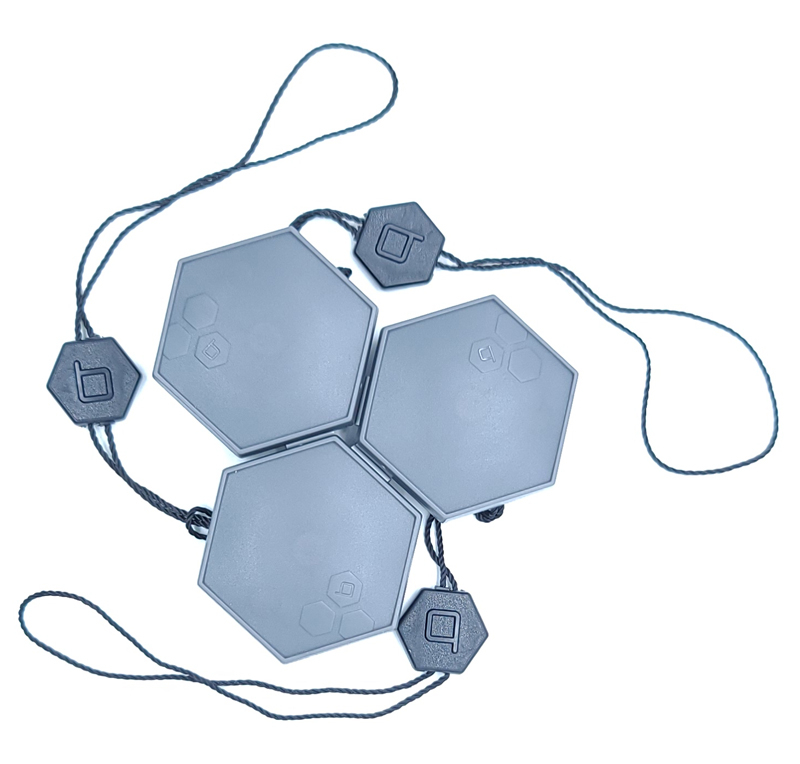
REVIEW – Water is an essential part of life. We need it to survive. It’s nice to float in on a hot summer day. But, if it shows up in the wrong place at the wrong time, it can create a disaster in your home. Orbit is mainly known for its water flow solutions, like irrigation timers and hose faucet timers. They market these under the B-hyve name. In an effort to expand to all things H2O, Orbit has added smart flood sensors to the B-hyve line of products. Do they help keep you high and dry, or are they all wet? Let’s dive in!
What is it?
The Orbit B-hyve smart flood sensor solution is a combination of a B-hyve WiFi hub and one or more battery-powered remote B-hyve Bluetooth liquid and temperature sensors.
What’s in the box?
I was sent the sensor three-pack with the hub.
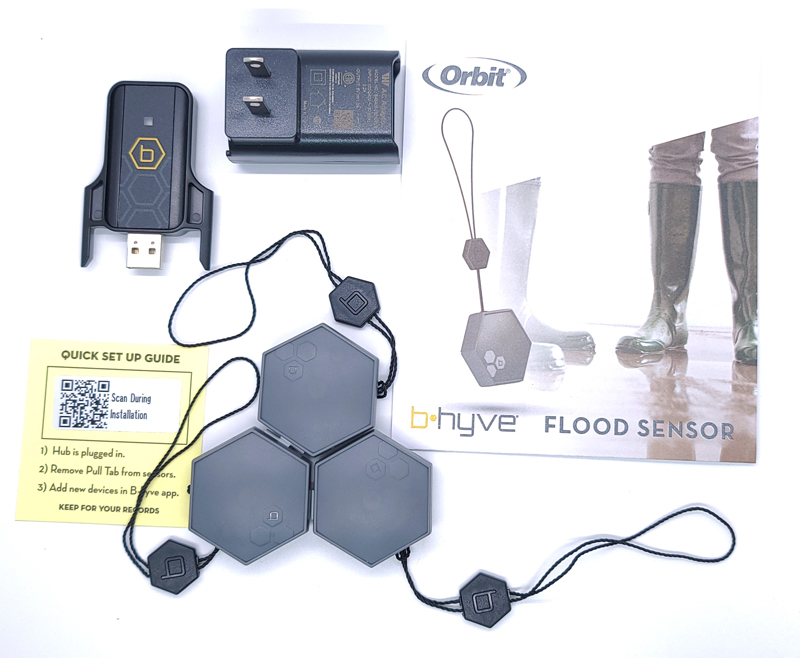
- B-hyve flood sensor with retrieval cord (x3)
- USB WiFi hub
- USB power supply for the hub
- Quick setup QR code
- Manual
Hardware specs
- Sensor size: 1.75″ point-to-point, 1.5″ flat-to-flat, 0.5″ thick
- Sensor retrieval cord: 6″
- Sensor weight: 0.5 ounce
- Bluetooth version: 5.0
- Bluetooth range: 300′ unobstructed
- Sensor batteries: CR2032 – one per sensor
- Expected battery life: about one year
- Wifi Bandwidth: 2.4Ghz only
- Hub power requirements: 100-240V AC
- App Compatibility:
- iOS – iPhone, iPad, and iPod Touch running iOS 8 and higher.
- Android – Android version 4.3 and higher.
Design and features
The hub is essentially a two-part device.
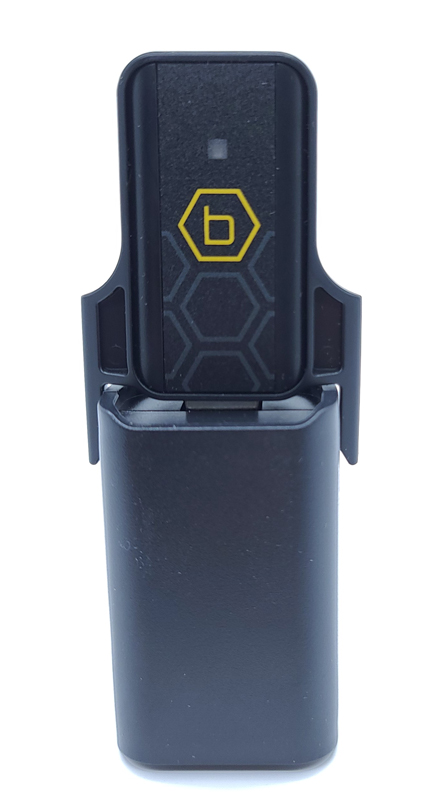
The hub itself has a USB-A connector on it. That plugs into the power supply and the power supply plugs into a wall socket. The yellow “b” is a button that can be used to force pairing. I didn’t have to use it at all during the setup.
The sensor is a hexagonal shape.

The top features the B-hyve “b” logo on it with a couple of additional raised hex shapes. The back is where the action is.
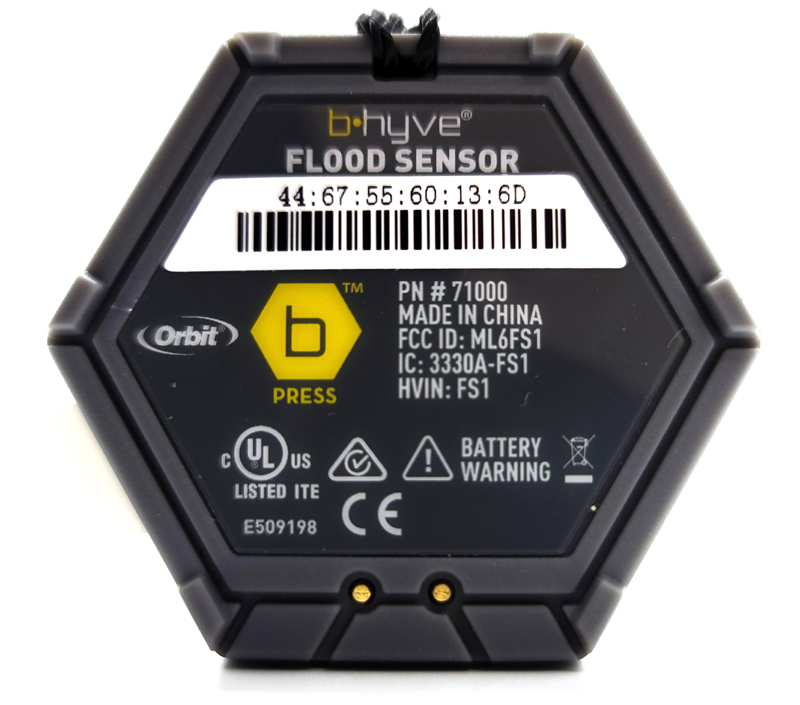
The MAC address is listed on a barcode label. The yellow “b” logo is another setup button. I didn’t have to use either the button or the barcode during setup – more on that below.
On each corner, you can see a small foot that keeps the sensor just above the surface where it is placed. You can see the channels all around the outside edge that allows liquid to run into the sensor, directing it to the two small gold sensors. When the two gold pins come in contact with liquid, it trips the sensor.
At the top of the photo, you can see the loop of the attached retrieval cord. The sensors are quite thin and are designed to shove underneath items where liquid might leak. The idea is to push the sensor under and leave the cord where you can get a finger on it and retrieve the sensor when the battery needs to be changed. The sensors report relative battery strength to the app and will alert when the battery needs to be replaced.
The sensors also have a built-in temperature monitor. The sensors can either be used to detect liquid or to detect temperatures outside a user-selected range.
Setup
Setup starts with installing the B-hyve app from the appropriate app store and creating an account. To me, the app appears very sprinkler-centric. The flood sensors seemed to be an afterthought. But, everything works fine, so that’s just my opinion.
As soon as you get the app installed and your account created, the app steps you through the installation process by telling you to plug in the hub and pulling the “pull me” tabs on each sensor. The sensors ship with protective tabs installed that prevent the battery from supplying power to the sensor. This ensures your sensors arrive with a fully charged battery.
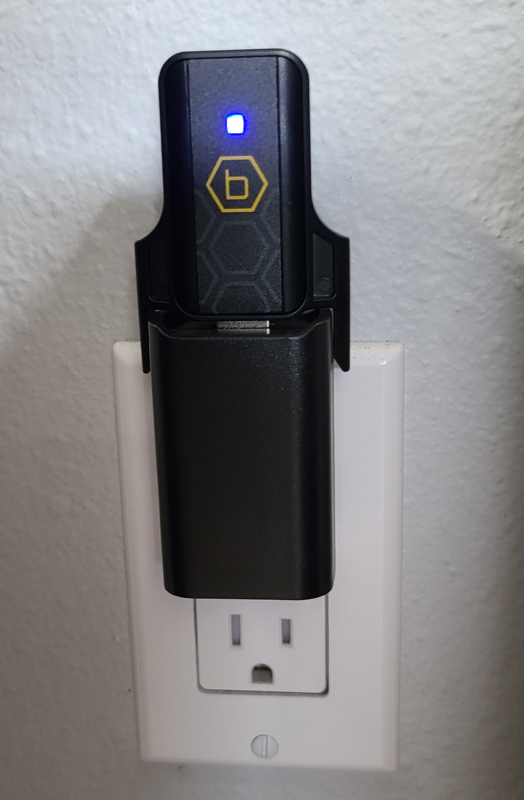
The hub flashed blue while pairing to my WiFi and then turned solid green. If you look back at the “what’s in the box”, photo, you can see the QR code that Orbit supplied. The app asked me to scan the QR code. This code is unique to the kit you are sent and provides the app with all the required information to find the hub and pair all the sensors to the hub. After I scanned it, the app found all four items, asked me to choose a WiFI network, and supply my password. Read this in your best Forrest Gump voice: and just like that, my hub and sensors were online.
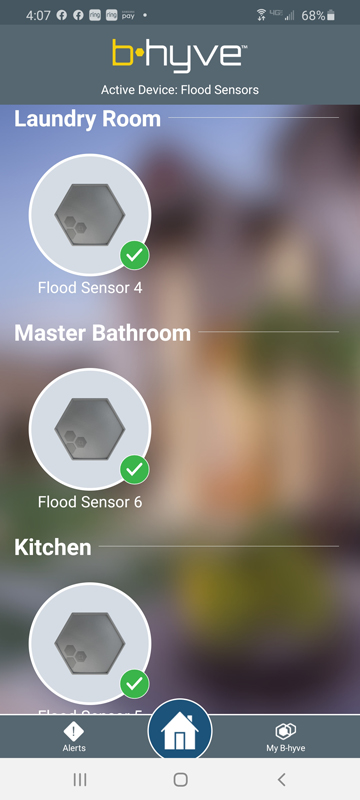
The app lets you name each sensor with meaningful names for locations or specific devices.
Performance
To test the sensor, I placed it in my kitchen sink and turned on the faucet very low so that water would filter under the sensor.
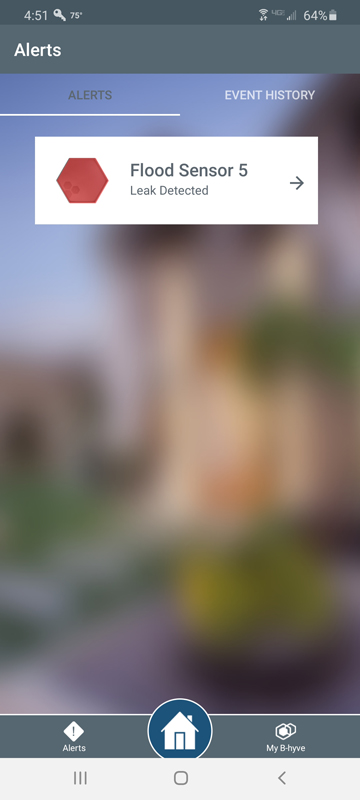
Almost immediately, the sensor started making a very faint beep/click and my phone alerted. Clicking on the alert provides more information.
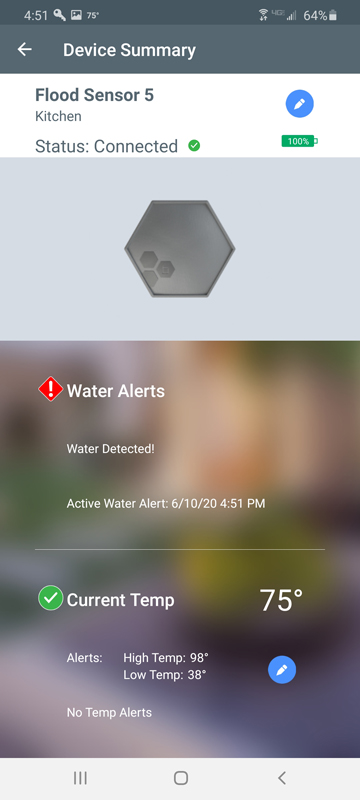
It shows the alert and also provides current temperature information. The temperature alert range is configurable. To test that, I set it to +10/-10 and tossed it in my freezer.
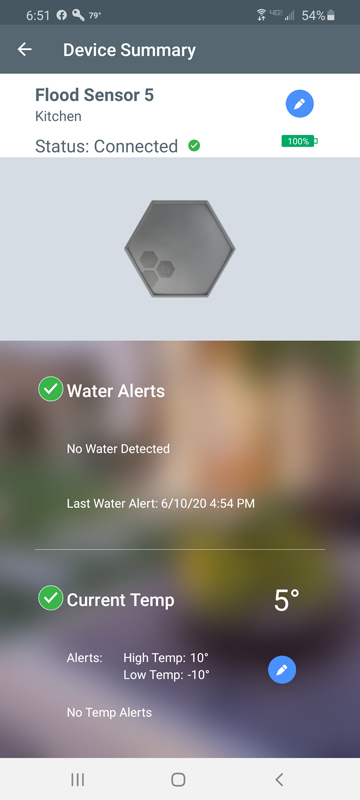
After the sensor acclimated, I pulled it back out of the freezer and set it on the counter. A few minutes later, my phone alerted.

Looking at the alert in the app, we see what’s happening.
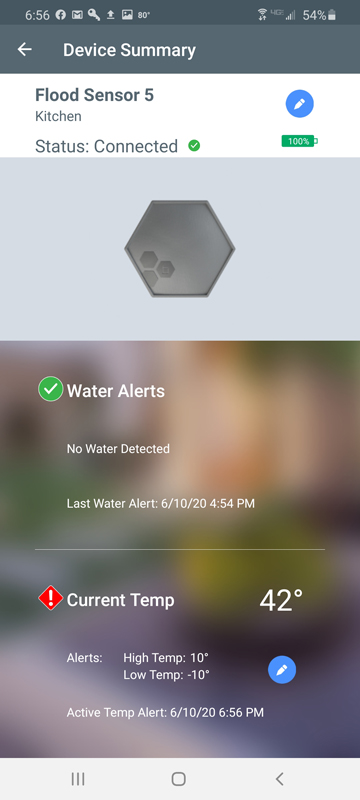
The app also emails you all alerts, so even if you miss the push alert, you will have email as a backup.
The hub is located in my kitchen in a wall socket about a foot off the ground. I put a sensor in my master bathroom, perhaps 30-40 feet away from the sensor, through a couple of metal-stud construction walls. I experienced absolutely no connection problems and when I tested that sensor, I received immediate alerts.
As I was writing this, I wanted to try one more alert. For some reason, everything stopped working. The app shows everything online and available, yet when I put any of the sensors in water, I got no alerts. Weird. Then, about five minutes later, I got all the appropriate alerts and emails. No idea why the delay, but it was certainly different than my initial tests.
I do have one more complaint/suggestion – make the alert sound configurable. The app has no option for changing the alert sound, so it uses my phone’s default sound. I want a more insistent alert for something like a flooding floor. Of course, I can change it by configuring the individual alerts, but it would be nice if the app had that option.
What I like
- Easy setup
- Fast alert, at least some of the time
- Handles both liquid and temperature alerts
- Small-sized sensors can go almost anywhere
What I’d change
- Make the alert speed consistent – perhaps they were having issues, but still…
- Allow for custom alert sounds in the app
- Have a more audible alert tone from the sensor itself
Final thoughts
I can see getting more of these sensors. I would put one under our three bathroom sinks, behind our two toilets, under the kitchen sink, laundry sink, washer, and refrigerator. I can also see putting one inside our two refrigerators to monitor for failures. One issue with that is that as of this writing, only the sensor three-pack with a hub is in stock. None of the other packages are currently available. I hope that is a short-term situation.
The alert delay I experienced was a little concerning, but I did receive the alerts in just a few minutes.
The sensors are so small and unobtrusive, they can go just about anywhere without affecting and design aesthetics. Their one-year battery life means I won’t be constantly swapping batteries.
If you are concerned about water leaks or live in an area where water can get in your home, the B-hyve smart flood sensor system can give you a little peace of mind and monitor things so you can respond if needed. Add to that the fact they the system can also monitor temperature and provide freeze or high-temp alerts and you have a well-rounded home monitoring solution.
Price:
- $34.99 for one sensor
- $99.99 for the three-pack of sensors with the hub
- $99.99 for a five-pack of sensors
- $189.99 for an eight-pack of sensors with a hub
- $469.99 for a 20-pack of sensors and two hubs plus an additional sensor
Where to buy: Orbit
Source: The sample of this product was provided by Orbit.



Gadgeteer Comment Policy - Please read before commenting
Yet another device that requires one to create an account in their ecosystem. We have to count on Orbit being around for as long as we want to use their gizmo.
I just setup a couple B-Hyve hose timers so I am guessing this would be a logical addition to the existing hub I have already setup in my app. Thanks for the review. Much appreciated.
They should connect to your existing hub, Robert, so you can save a couple of bucks just buying the sensors. Enjoy and thanks for reading!
Bought 3 flood sensors and hub, no happy. They keep disconnecting, moved the hub closer to the worst one . No help. Save your money till they get it right. Otherwise you will really Love those 2am flood sensor has disconnected alerts !
Phillip:
For what it’s worth, recently, I’ve been having disconnected/reconnected issues with one sensor. I swapped the battery for a fresh one and the issue disappeared.
I’ll give it a try , thanks !
They didn’t work every well at all. Range of sensors sucks, I had one in each bathroom and one the kitchen in a 1800 square foot house and keep losing connection to the sensors with the hub in the middle of them. Called support and they confirmed my placement and distance between sensors and hud was well within the limits of the product. Didn’t even work we’ll in line of sight 30 feet away. Returned for a refund. Bluetooth is the wrong communications method for this product, the hud is WiFi but, the sensors are Bluetooth and the range sucks.
Sorry you had that experience, Bob. I live in a 2,000 square foot single floor home with metal stud construction. The hub is located more-or-less in the middle with the three sensors spread throughout and I have had connectivity issues twice with one sensor since writing the review, but it comes back online almost immediately. That one is behind a toilet with three metal stud walls and the toilet between it and the hub. The one under the refrigerator and the other under the washer have been solid 100% of the time.
I have an b-hyve irrigation controller mounted outside the rear of my garage and a pair of water heaters in my attic. I suspect, if I installed the sensors in the attic, there probably would be connectivity issues to the controller?
The house is wood-framed with a stucco exterior.
Kenneth:
Where is the hub located? That’s the item that has to talk to everything. As long as you can position the hub within a claimed 300 feet of everything, you should be good. From a practical standpoint, as long as you can get the bub within 50-100 feet in a wood-framed structure, I expect you’ll have no connectivity issues.
I have a built-in Rainpoint sprinkler system, but in Texas drought conditions this is nice to have to get to those patches of grass that the built-in systems can’t get to. Set up was a little tricky since my 2.4G & 5G networks share the same name, but it can be done by moving away from your router (2.4G has longer range than 5G). The app is intuitive and easy to use. Time will tell how durable this unit will be, hence the 4-star review for now, but I already ordered a second unit (without the hub) and it paired nicely with the original hub. Now I have much more coverage than before…especially useful when going on vacation.
https://www.rainpointonline.com/